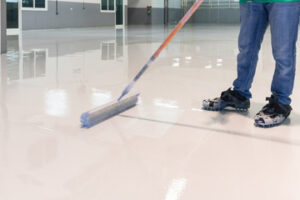Epoxy Flooring WV is becoming more popular in both residential and commercial settings. This resinous flooring is easy to clean, durable, and customizable.

It protects the underlying concrete surface, making it resistant to damage. It can also withstand exposure to various chemicals.
Epoxy is light-reflective, allowing existing lighting to brighten the space. This is particularly beneficial for commercial showrooms and residential garages.
One of the best things about epoxy flooring is its high durability. Whether you choose to have it installed in your garage, living area, industrial setting, or commercial center, the durable material will resist impact and stand up to heavy foot traffic for years to come. This durability also makes it very easy to clean, as spills and dirt can be swept or mopped away with ease.
Epoxy floors are also water-resistant, which makes them perfect for areas that may experience flooding or chemical spills. Because the floor coating creates an impenetrable barrier, the toxins won’t seep into the concrete and become more difficult to remove. This also ensures that your employees are working in a safe environment.
In addition, epoxy flooring is extremely strong and can withstand heavy foot traffic, machinery, and even chemical spills. This type of flooring is perfect for commercial spaces that are open to the public and need a sturdy surface that can handle the daily grind.
The durability of epoxy can also make it a great choice for residential areas, where kids and pets will play. The resilient material will withstand impact without scratching or denting, which is ideal for any family home.
If you are planning to use your garage for work, be sure to put down plywood or mats in areas where you will be welding and using other tools that could damage the floor. Also, it’s a good idea to have a mop bucket and broom handy, as well as a rag with some mild detergent or vinegar and water.
Even if your floor does get stained, you can often remove it with a little bit of warm water and a kitchen sponge or soft scrub pad. Avoid steel wool or harsh chemicals like Comet, as they can discolor and damage the epoxy finish.
While regular sweeping and mopping is usually enough to keep your floors looking their best, it’s also a good idea to have them professionally cleaned every once in a while. A professional will be able to deep clean the flooring with a machine that scrapes and suctions up any dirt or grime that is stuck to the surface.
Easy to Clean
Epoxy floors are one of the easiest flooring surfaces to keep clean. They can be swept or vacuumed regularly to remove dust, dirt and debris from the surface. For a more thorough cleaning, a mild soap and water mop can be used. The floor can also be rinsed with a hose or bucket of water to ensure that any dirt is carried away and won’t remain as residue. This will keep the floor safe and free from bacteria, mold, and other harmful pathogens that could otherwise cause health issues in your facility.
Stains on epoxy can often be removed by gently scrubbing the surface with kitchen scrubbers, pads or soft deck brushes and warm water. If the stain is particularly stubborn or has been sitting for a long time, a small amount of ammonia can be mixed in with the cleaning solution. However, this must be done carefully so as not to degloss the epoxy.
For heavy duty areas where chemicals, oils, and other toxic substances are spilled frequently, a stronger scrubber may be required. It is important to scrub these high-traffic areas daily to prevent buildup and keep the area safe for staff members. If you have an industrial environment where these types of materials are frequently used, consider investing in protective mats for areas like the garage, warehouse or workshop. This can help to reduce the number of times your employees need to use a harsh scrubber, which will in turn extend the life of your epoxy flooring.
Keeping up with regular sweeping and mopping is essential in maintaining an epoxy floor’s appearance. You should also use a broom with extensions to reach all the corners and crevices of your garage or warehouse. This will help to prevent the accumulation of dust, dirt and other debris that can lead to abrasions and damage the epoxy surface.
It is important to always be mindful of your foot and wheel placement on an epoxy floor as excessive pressure on the surface can damage or peel the coating. Avoid dragging or dropping heavy machinery or pallets as this can cause deep gouges in the epoxy. If you must, be sure to put down plywood or another protective mat to prevent the floor from being scratched.
Anti-Slip
Slips and falls in commercial or industrial settings can result in costly lawsuits and lost productivity. The good news is that epoxy flooring with anti-slip properties can help to prevent this risk by providing better traction to reduce the chances of accidents. The slip-resistance of epoxy floors is achieved by incorporating additives like silica or aluminum oxide into the top coat during the installation process. These aggregates create a textured surface that is more resistant to sliding and improves overall traction, helping to prevent injuries from falling.
Non-slip epoxy coatings are also designed to hold up against frequent spills and wet conditions. They are more resilient than traditional concrete, and they can withstand heavy foot traffic. Furthermore, they are resistant to chemicals that might otherwise damage or stain the floor, and they can be cleaned with regular cleaning products without causing any problems.
One of the biggest causes of slip and fall incidents is due to slippery floors. Whether it is from a spilled substance or simply from the wet surface, many people lose their balance and fall over. This can be particularly dangerous in high-traffic areas such as warehouses, retail stores and other public spaces.
To prevent this from happening, a slip-resistant finish is essential. Incorporating the right additives into the epoxy coating can help to prevent these incidents, minimising the risks for employees and visitors alike.
The best way to ensure that the final product has a high coefficient of friction is to consult with a professional. They can provide advice on the best materials to use and recommend the ideal application method for each space. This will ensure that the flooring is durable, aesthetically pleasing and most importantly, slip-resistant.
A lot of people mistakenly think that adding sand to the epoxy coating will make it slip-resistant. However, the reality is that sand can actually be quite slippery, especially in wet or greasy conditions. Silica sand (also known as quartz sand) is a much more effective option for creating slip resistance in epoxy floor coatings, and it can be customized to suit the needs of the specific environment. For example, some environments may require a finer abrasive such as silica to maintain their slip resistance, while others might need a coarser material that can withstand more wear and tear, such as aluminium oxide.
Light Reflective
Epoxy flooring creates a clean, modern environment that enhances the aesthetic of residential spaces and commercial establishments. It is available in a wide variety of colors and textures, with the ability to incorporate logos or designs into the surface to match a specific style. The glossy finish also helps to prevent cracks and joints from collecting dirt and debris, further improving hygiene and appearance. Additionally, epoxy flooring is easy to clean and durable enough to withstand heavy traffic and use.
Despite its versatility, it is essential to work with a professional when installing epoxy floors. Experts will thoroughly prepare the floor to ensure that it is ready for a smooth application and strong bond with the concrete substrate. This process includes removing any loose particles and degreasing to ensure that the epoxy adheres properly. Additionally, a surface profile such as diamond grinding or shot blasting may be used to create a rough texture that improves adhesion and durability.
In addition to a durable surface, the light-reflective properties of epoxy make it an attractive option for residential and commercial floors. During the installation process, experts can manipulate pigments to form reflective patterns that scatter light in beautiful ways. The result is a high-gloss finish that adds a sophisticated aesthetic to any space. Additionally, the neutral color of epoxy allows it to be resurfaced when necessary, extending its lifespan and value.
Although the long-lasting nature and durability of epoxy floors are a huge selling point, they require regular maintenance to prolong their life. Incorporating walk-off mats and entry rugs can help to limit wear from debris or moisture, while regular inspections can identify any areas that need repair. The use of appropriate footwear and spill management strategies can also reduce wear.
Keeping your epoxy floor well-maintained will extend its lifespan and increase its value, making it an excellent investment for homeowners and businesses. Regular cleaning, effective spill management, and implementing safety measures such as the use of protective pads or sliders can all significantly reduce wear and tear and protect the floor from stains and damage.




